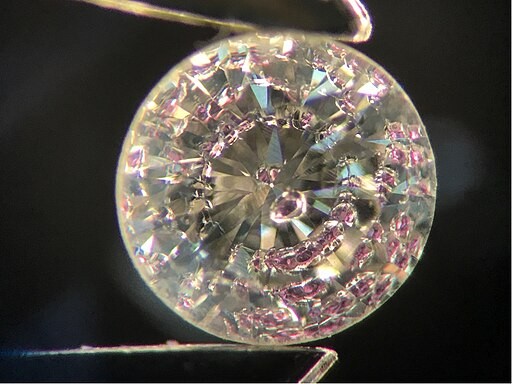Due to its exceptional hardness, diamond is considered Earth's hardest material, demonstrating high thermal conductivity and electrically insulating properties. In a recent study, an elusive material theorized several decades ago was finally synthesized, demonstrating resistance to heat and pressure as effectively as diamonds.

How Hard Is Diamond?
The hardness of a material is a property that is determined in terms of scratch resistance. Experts describe this property using the Mohs Hardness Scale, which rates relative hardness among materials. According to this scale, a substance can only be scratched by something of equal or greater hardness.
Diamond sits at the top of the Mohs scale at number 10, making it the hardest material in the world. This means that only a diamond can scratch another diamond. However, hardness is non-linear, and it is calculated that the diamond is many times harder than the next hardest substance at 9.
Diamond is made up of pure carbon, and the bonding of its atoms makes it the hardest material. The extremely strong bonding makes this gem superior to other substances. However, there is one direction where the bonds are not as strong, and the diamond can be cleaved along this direction with impact. Aside from atomic bonding, the durability and hardness of a diamond also depend on its girdle thickness and purity.
READ ALSO: Fullerite Becomes Ultra-Hard Material: Russian Scientists Says It's Harder Than Diamond
Unbreakable Rival
In 1989, it was theorized that material made by combining carbon and nitrogen, called carbon nitride, would be less compressible and more resistant to shearing. During this time, experts first noticed its exceptional properties, such as high resistance to heat. Since then, materials researchers have attempted to unlock its potential, but no credible results were reported after decades of attempts to synthesize it.
In a recent breakthrough in materials science, an international team of scientists has finally solved the decades-long puzzle and unveiled an almost unbreakable substance. The study "Synthesis of Ultra-Incompressible and Recoverable Carbon Nitrides Featuring CN4 Tetrahedra."
It is conducted by a team of researchers from the Centre for Science at Extreme Conditions at the University of Edinburgh in collaboration with experts from the University of Linköping, Sweden.
Various carbon-nitrogen precursors were subjected to pressures of between 70 and 135 gigapascals, around one million times our atmospheric pressure, to make the ultra-incompressible carbon nitride. This was done while heating them to temperatures of more than one and a half degrees Celsius.
The samples were illuminated by an intense X-ray beam to identify the atomic arrangement of the compounds under extreme conditions. The process used three particle accelerators - the Advanced Photon Source in the US, the Deutsches Elektronen-Synchrotron in Germany, and the European Synchrotron Research Facility in France.
Three carbon nitride compounds were discovered to possess the building blocks required to possess super-hardness. Remarkably, all three retained their diamond-like properties upon returning to ambient pressure and temperature conditions. Further analysis also suggests that the new materials contain additional properties like photoluminescence. They also have high energy density, where a large amount of energy can be stored in just a small mass.
The findings suggest that the resulting materials will be tougher than cubic boron nitride, the second hardest material after diamond. According to the researchers, the potential applications of these ultra-hard carbon nitrides potentially place them as ultimate engineering materials to rival diamonds.
This breakthrough can provide opportunities for multifunctional materials that can be applied in various industries. They can be used for industrial purposes such as protective coatings for cars and spaceships, production of high-endurance cutting tools, and making solar panels and photodetectors.
RELATED ARTICLE: Artificial Hexagonal Diamonds Stiffer Than Natural Cubic Diamonds, Potential Material for Industrial and Scientific Applications
Check out more news and information on Diamond in Science Times.














